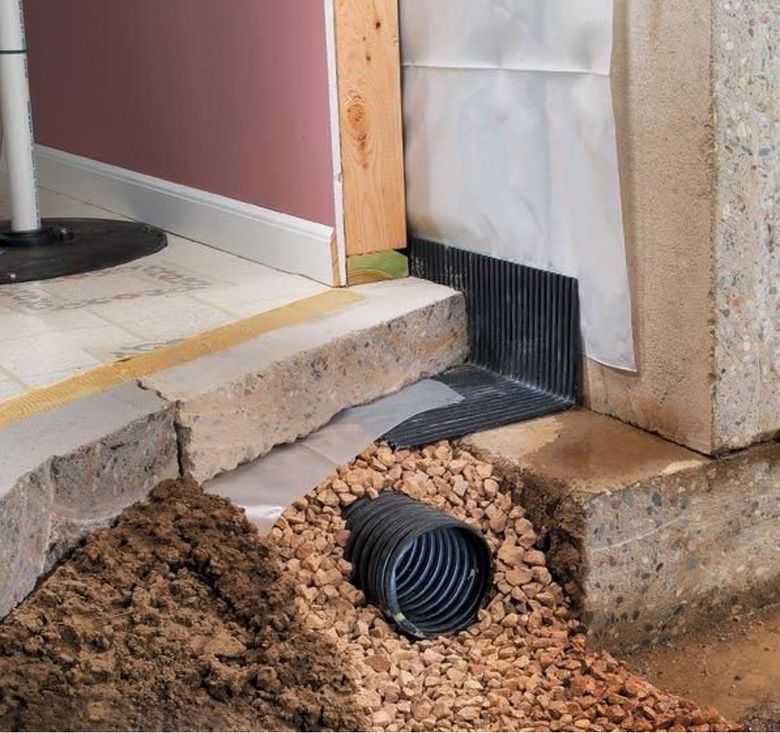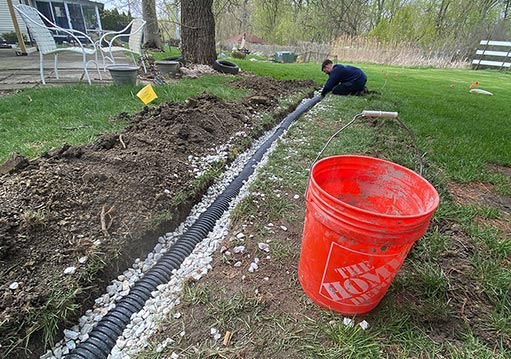Evaluating DIY vs. Professional Portland French Drain Construction
Evaluating DIY vs. Professional Portland French Drain Construction
Blog Article
Just How a French Drainpipe Can Assist Prevent Water Damage in Your Basement
A French drainpipe could be the service you need if you're dealing with a damp cellar. This system successfully redirects water far from your foundation, assisting to avoid costly damage. Comprehending how it functions and identifying the indicators that you require one can make a significant difference in your home's safety and convenience. Before you decide, it's critical to check out the benefits and setup process to see if it's the appropriate fit for your scenario.
What Is a French Drainpipe?
A French drain is an easy yet effective option for taking care of excess water around your residential property. It's developed to redirect water away from at risk areas, like your basement or foundation. Generally, it contains a trench full of gravel and a perforated pipeline that collects and networks water. When rain or groundwater develops up, the drainpipe successfully guides it away, avoiding prospective damage.You could see French drains pipes set up along building lines, driveways, or perhaps near your home's foundation. They come in numerous sizes and configurations, making them versatile to various landscapes and drain needs. Mounting a French drainpipe can help you prevent pricey fixings and shield your home's structural integrity. If you've been managing water pooling or soaked areas in your lawn, a French drain can be the solution you require. It's a proactive step to ensure your residential property stays risk-free and completely dry from water-related concerns.
How Does a French Drainpipe Job?
When water gathers around your residential property, a French drainpipe kicks into activity to redirect it properly. This system contains a trench full of gravel and a perforated pipeline near the bottom. The pipeline accumulates excess water from the soil and networks it far from your foundation.As rainwater or groundwater seeps into the crushed rock, it streams via the perforations and right into the pipeline. Gravity does the work, drawing the water away from your cellar and directing it to an assigned drainage location, like a tornado drain or completely dry well.You can set up a French drain either inside or outside your home. It'll protect against water from pooling near your structure if you choose an outside setup. An interior drainpipe will catch water that seeps through your basement wall surfaces. This effective style maintains your space dry, enabling you to appreciate your home without the fear of water damages.
Advantages of Setting Up a French Drain
Mounting a French drainpipe can significantly boost your home's strength versus water damages. You'll enjoy efficient water diversion, which assists decrease mold and mildew growth and safeguard your residential property. And also, a well-kept drain system can even enhance your residential or commercial property's value.
Effective Water Diversion

Reduced Mold Growth
Because moisture produces a best setting for mold to grow, minimizing water build-up around your home is vital for preserving a healthy living space. Setting up a French drain properly channels excess water far from your foundation, keeping your cellar dry. This proactive step significantly reduces humidity degrees, making it harder for mold and mildew spores to work out and grow.With much less moisture, you'll locate it simpler to take a breath and appreciate a tidy, secure environment. Plus, you'll decrease the danger of health problems linked with mold direct exposure, such as allergies and respiratory troubles. By spending in a French drainpipe, you're taking a vital action toward a mold-free basement, guaranteeing that your home stays a comfortable place for you and your household.
Enhanced Property Value
A French drain can substantially improve your home's value, making it a smart financial investment for homeowners. When possible purchasers see a well-kept cellar devoid of water damage, they're more probable to be amazed. This function not only improves your home's allure but additionally signifies that you have actually taken aggressive steps to secure it. By lowering the threat of water-related problems, your building becomes extra eye-catching in an open market, often leading to greater deals. In addition, the lasting savings on repair work and maintenance can convert right into enhanced equity. Installing a French drain reveals you appreciate your home's honesty, reassuring buyers that they're making a sound purchase. Inevitably, it's a useful enhancement that repays in even more methods than one.
Indications You Need a French Drainpipe
If you see persistent water build-up in your backyard or basement, it's a clear indicator that you might require a French drain. In addition, a moldy smell can indicate trapped dampness, which can bring about bigger problems. Dealing with these indications early can help prevent major water damage to your home.
Persistent Water Accumulation
It's a clear indication that a French drain might be needed when you observe relentless water buildup around your home. Water pooling near your foundation can cause substantial damage gradually, including structural issues and mold growth. You should take notice of areas where water seems to collect after hefty rainfalls or snowmelt. It's time to take action if your backyard remains soggy for days. Additionally, look for signs of erosion or muddy patches, as these can show bad drain. Setting up a French drain aids reroute water far from your home, safeguarding your foundation and minimizing the danger of water damages. Don't wait on larger concerns to arise-- dealing with water accumulation currently can conserve you expensive repairs later on.
Mildewy Smell Presence
Consistent water buildup commonly causes even more than just visible merging; it can create an atmosphere ripe for stuffy odors. If you discover a damp, stale scent in your basement, it's an indication that wetness is remaining, commonly due to bad drainage. This smell usually suggests mold and mildew or mildew growth, which can posture health threats and harm your personal belongings. You could find that the smell worsens throughout humid climate or after hefty rains. If you're battling persistent musty smells, it's time to assess a French drain. This system reroutes water away from your foundation, decreasing moisture degrees and combating those unpleasant smells. Do not ignore this indication; resolving it promptly can save you from extra extensive water damage down the line.
The Setup Process of a French Drain
Installing a French drain can be a simple procedure that substantially boosts your home's water damage prevention. Initially, evaluate the area where you want to set up the drainpipe, guaranteeing it slopes far from your structure. Next, note the trench's path, which should have to do with 6-8 inches large and 18-24 inches deep.Excavate the trench, getting rid of dirt as needed. Portland French Drain. When you've obtained your trench, set landscape textile to stop soil from blocking the drain. Then, add a layer of crushed rock at the base. Location a perforated pipeline on top of the crushed rock, ensuring the holes face downward for efficient drainage.Cover the pipeline with even more crushed rock, leaving concerning 3 inches of area on top. Fold up the landscape material over the gravel to safeguard it. Lastly, fill in the trench with soil, condensing it as you go. You have actually currently established up this content a trusted system to redirect water away from your basement!
Maintenance Tips for Your French Drainpipe
A French drainpipe is created to efficiently manage water circulation, routine upkeep is crucial to confirm its ongoing efficiency. Beginning by inspecting the drain and its environments for debris or obstructions. Clear any kind of fallen leaves, dust, or sediment that may collect, particularly after heavy rains.Next, examine the outlet for correct drain. It must route water far from your foundation-- if it does not, you might need to adjust its setting. In addition, verify that the crushed rock bordering the drainpipe is intact and hasn't resolved over time; this helps maintain appropriate water flow.Consider scheduling a yearly professional assessment to capture any issues early. If you discover any indications of water damage or merging, address them quickly to avoid larger issues later on. With a little interest, your French drainpipe can successfully protect your cellar for several years to find.
Price Considerations and Long-Term Cost Savings
When taking into consideration a French drain, it's essential to weigh both the first investment and the long-term cost savings it can give. While the upfront cost could appear considerable, think of it as an investment in your house's future. Mounting a French drainpipe typically varies from $1,500 to $5,500, depending upon your cellar's size and the complexity of the installation.However, this expense can save you thousands in possible water damage, mold removal, and structure repair work. By stopping water accumulation, you're additionally securing your home's worth and preventing pricey insurance claims. Additionally, a dry cellar can informative post lower your power costs, as dampness can result in raised home heating and air conditioning costs. Ultimately, the comfort that features knowing your home is guarded from water damages is invaluable. Consider these elements meticulously to make a well-informed choice that benefits you in the future.

Regularly Asked Inquiries
Can a French Drain Be Mounted in Any Type Of Sort Of Dirt?
Yes, a French drainpipe can be set up in numerous dirt types, consisting of sand, loam, and clay. Correct setup and water drainage planning are important to ensure it functions effectively in your details soil problems.
For how long Does a French Drainpipe Last Before Needing Replacement?
A French drainpipe generally lasts around 30 to 40 years with proper installment and upkeep. Aspects like soil type and water flow can affect its lifespan, so keep an eye on its performance.
Can French Drains Aid With Lawn Water Drainage Issues?
Yes, French drains can properly attend to yard water drainage concerns. They route excess water far from trouble areas, preventing merging and guaranteeing your landscape stays healthy and balanced. Installing one can significantly boost your lawn's overall water drainage performance.
Will a French Drain Impact My Landscape Design or Garden?
A French drain can impact your landscaping or yard, especially if it's installed poorly. You'll wish to make sure it's placed strategically to reduce interruption, maintaining your plants and total aesthetic while improving water drainage.
Exist Alternatives to French Drainpipes for Cellar Water Problems?
Yes, there are choices to French drains pipes for basement water concerns. You might take into consideration sump pumps, waterproof layers, or rating your yard to reroute water away. Each alternative has its advantages, so review what suits your requirements best. When rainwater or groundwater find here constructs up, the drainpipe successfully overviews it away, stopping possible damage.You might discover French drains pipes mounted along building lines, driveways, or also near your home's foundation. Gravity does the job, drawing the water away from your basement and guiding it to a designated water drainage location, like a storm drainpipe or dry well.You can set up a French drain either inside or outside your home. By efficiently transporting water away from your building, a French drainpipe can significantly reduce the danger of water damages. Setting up a French drain aids redirect water away from your home, protecting your foundation and decreasing the risk of water damages. Installing a French drain can be an uncomplicated procedure that substantially improves your home's water damages prevention.
Report this page